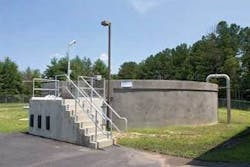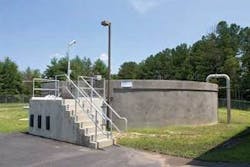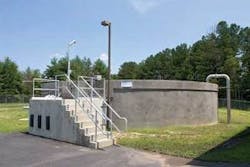Solids Reduction Process also Reduces Energy Costs
By Betty-Ann Curtis
A relatively new treatment process offered by Siemens Water Technologies is designed to reduce the amount of biological solids generated by wastewater treatment facilities. As a side benefit, it also can reduce the amount of aeration required, which can lead to energy savings.
The company’s CannibalTM process incorporates a sidestream module for separation and removal of non-readily degradable solids, and a sidestream interchange reactor to condition biological solids for enhanced degradation. Since routine wasting is greatly reduced with this system, return activated sludge is sent through the solids separation module, where ultra-fine mesh screens and hydrocyclones remove trash, grit and inert material that would otherwise build up in the mixed liquor. This material, not removed in typical headworks, commonly makes up 20% to 25% of the mixed liquor solids. The screenings are compressed to 30% to 50% solids and are routinely removed from the plant, usually to a landfill.
The sidestream interchange tank receives biological solids that would normally be wasted from the main plant. In this tank, a unique conditioning environment is created. Minimal aeration is used in the interchange tanks. The oxidant reduction potential (ORP) is carefully monitored so that air is only supplied for short periods of time when the ORP becomes too low. In this low- ORP environment, aerobic bacteria are conditioned for destruction and biodegradation, making their by-products available for facultative bacteria that can survive in this environment.
A portion of the sidestream tank is interchanged back into the main treatment process where biodegradation is completed and the facultative bacteria are out-competed by the aerobic bacteria. As the solids are interchanged and cycled between the aerobic and non-aerobic environments of the aeration basin and interchange tanks, solids are destroyed and the effective biological solids yield is significantly reduced. The result is that biological solids only need to be purged periodically from the system.
For many U.S. municipal wastewater treatment plants, this sidestream process, when incorporated into the main biological wastewater treatment facility, has helped reduce the cost of both sludge disposal and the amount of energy used to treat and stabilize the sludge. The interchange tank is typically aerated just 5 to 10 hours per week.
Optimized solids destruction can be realized when low ORP zones are also established in the main plant. To achieve such zones, the aerators in the main plant are carefully controlled to optimum power levels for treatment without over-aeration. This can lead to energy savings in the main biological process.
Case Study
A 6 mgd oxidation ditch plant in Alabama has been using the Cannibal process for over a year. The process saved the city nearly $95,000 in energy costs during its first year of operation. The energy savings came from the conversion of the aerobic digester to a Cannibal interchange tank and from operational changes in the main biological processes.
Prior to installing the process, the plant continuously aerated four aerobic digesters. After the installation, three of the four digesters are used for sidestream conditioning of biological solids and are being aerated just one hour a day. The fourth digester is used to stabilize the periodic purge of biological solids prior to dewatering and land application. This has reduced the plant’s power usage considerably.
Energy savings have also come from optimizing the oxidation ditches as an integral aspect of the Cannibal process performance. The ditches use four 100-hp aerators that are presently turned down or off during low-flow periods and during an interchange. Aerator optimization can be easily automated based on ORP values in the basin, taking advantage of power reductions during periods of low loading.
Competing Technologies
More stringent regulations on effluent quality, changing regulations for sludge stabilization and disposal, and the high cost of energy are causing the cost of wastewater treatment to increase.
Various products and processes entering the market promise to produce fewer solids for disposal. While most of these technologies are able to reduce the amount of sludge produced to varying degrees of success, they do so by breaking down the bacterial cells for enhanced sludge digestion. These systems tend to use a fairly large amount of energy.
The Cannibal solids reduction process differs from these other processes in that the sludge reduction comes from a biological process rather than a physical cell breakage process, and uses significantly less energy.
About the Author
Betty-Ann Curtis is director of the Cannibal process at Siemens Water Technologies in Waukesha, Wis. She joined Siemens three years ago and has worked in the biological wastewater treatment field since 1979. Curtis has a B.S. degree in Environmental Sciences from the University of Wisconsin in Green Bay and a M.S. degree in Civil and Environmental Engineering from Utah State University in Logan. She can be reached at 262-521-8408 or at [email protected].


